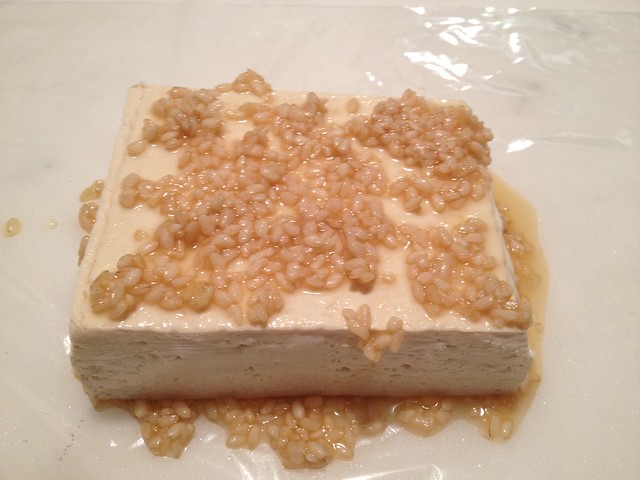 Shio koji
Shio koji, or 塩麹 (salted koji) is a going through a major boom in Japan right now. What is it? It is a mix of salt and
koji mold. Wiki says, "
Koji (Aspergillus oryzae) is a mold used in Chinese and Japanese cuisine to ferment soybeans. It is also used in the making of alcoholic beverages such as sake, and shochu."
Basically
koji is used to make miso and sake, to get its distinctive flavors.
Shio koji has been used widely in rural areas in Japan for a long time, but recently it has become a national sensation. Why is it so popular? Because it's an ingredient with super powers -- it tenderizes meat and adds sweet and salty flavors. You can only understand it if you use it.
It's yet not commercially available in the States (correct me if I'm wrong), but it's super easy to make, so I made it the other day.
All you need is
koji and sea salt. You can get
koji at Japanese grocery stores near the area where they sell miso. Sometimes you can find one in the rice aisle as well.
I bought this organic expensive koji brown rice, but if you can a find cheaper one, that's totally fine.
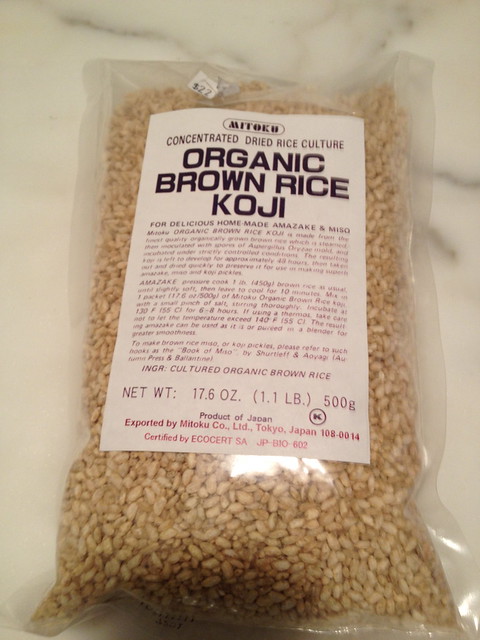
Mix
koji with salt. The ratio is about 30-40% salt to the
koji rice.

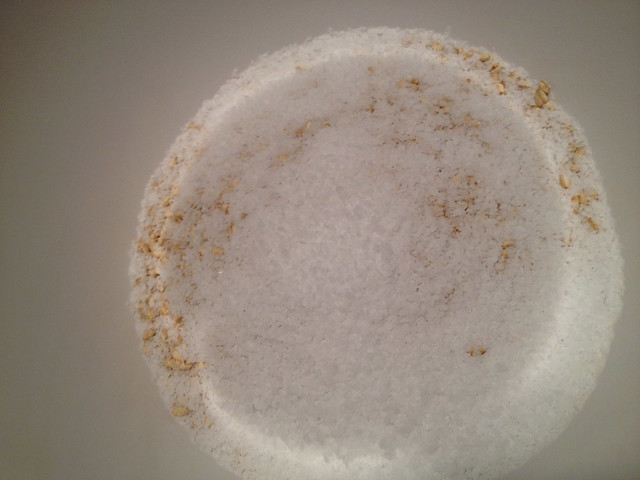
Mix them together well, and pour in water. That's basically it.
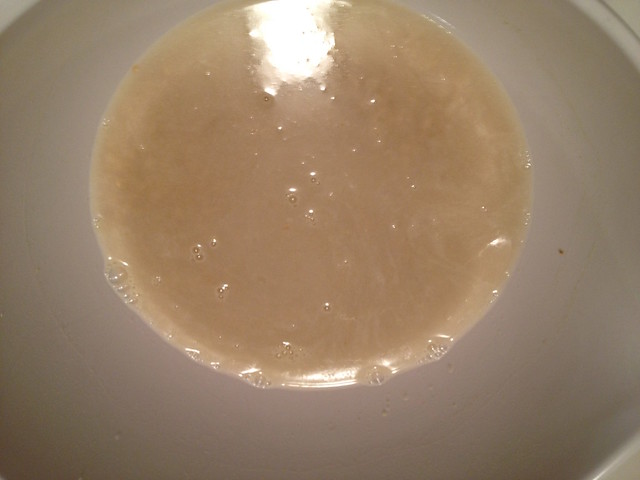
How much water? Make sure all the
koji is submerged in the water.
Then let it sit in room temperature for about 10 days. For the first few days, you will want to add more water so that all the
koji are submerged in the water.
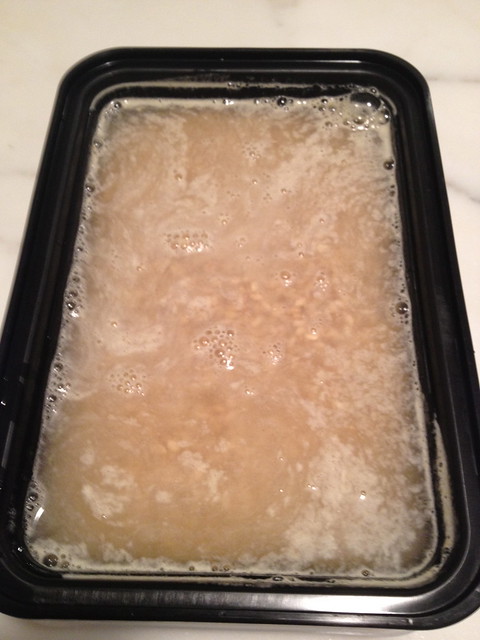
Even if rice isn't covered in water after a couple of days, it's ok. You also want to mix this daily. In the beginning, it's just salty water, but after about 10 days, it smells sweet -- somewhat similar to miso or sake (or some people say banana). You can also easily break the rice grains by pressing them with your fingers.
This was day two:

Once you make
shio koji, keep it in the fridge. It should last for about half a year, so you can make it in bulk.
This was about 10 days later. Smells very sweet, but tasted very mild -- not overpowering in saltiness at all.
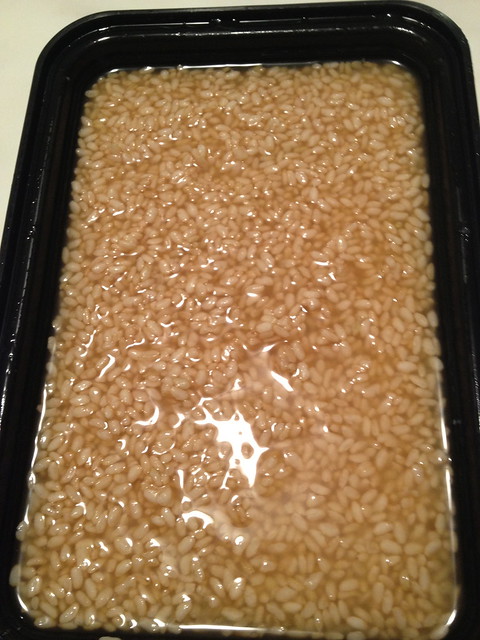
What do you use it for? Anything. Think of this as a salt substitute, but better. Marinate chicken (even breast meat) with about 2 tablespoons of it for an hour. It never makes dry chicken. Marinate fish with it and it will add a very nice sweet/salty flavor. Marinate tofu (you want to press the tofu to get rid of as much water as possible) and wrap it with the
koji for a week, it changes the texture and flavor of tofu completely. It makes something similar to cream cheese, but without any fat in it!!
I made
koji tofu, and it really changed the texture.

The options are limitless.
Shio koji produces a truly a magical flavor. It's apparently reduces salt intake as well since the salt is diluted with water and
koji rice. This is definitely the easiest recipe, so if you can find
koji rice near you, you should definitely try it.
Having said that, I made a second batch using
koji from Cold Mountain (a brand name). Even after two weeks, it wasn't easily breakable with fingers (although itsmelled and tasted good). I heard it was because
koji mold wasn't properly applied onto the rice. Something to think about.
 Shio koji, or 塩麹 (salted koji) is a going through a major boom in Japan right now. What is it? It is a mix of salt and koji mold. Wiki says, "Koji (Aspergillus oryzae) is a mold used in Chinese and Japanese cuisine to ferment soybeans. It is also used in the making of alcoholic beverages such as sake, and shochu."
Basically koji is used to make miso and sake, to get its distinctive flavors. Shio koji has been used widely in rural areas in Japan for a long time, but recently it has become a national sensation. Why is it so popular? Because it's an ingredient with super powers -- it tenderizes meat and adds sweet and salty flavors. You can only understand it if you use it.
It's yet not commercially available in the States (correct me if I'm wrong), but it's super easy to make, so I made it the other day.
All you need is koji and sea salt. You can get koji at Japanese grocery stores near the area where they sell miso. Sometimes you can find one in the rice aisle as well.
I bought this organic expensive koji brown rice, but if you can a find cheaper one, that's totally fine.
Shio koji, or 塩麹 (salted koji) is a going through a major boom in Japan right now. What is it? It is a mix of salt and koji mold. Wiki says, "Koji (Aspergillus oryzae) is a mold used in Chinese and Japanese cuisine to ferment soybeans. It is also used in the making of alcoholic beverages such as sake, and shochu."
Basically koji is used to make miso and sake, to get its distinctive flavors. Shio koji has been used widely in rural areas in Japan for a long time, but recently it has become a national sensation. Why is it so popular? Because it's an ingredient with super powers -- it tenderizes meat and adds sweet and salty flavors. You can only understand it if you use it.
It's yet not commercially available in the States (correct me if I'm wrong), but it's super easy to make, so I made it the other day.
All you need is koji and sea salt. You can get koji at Japanese grocery stores near the area where they sell miso. Sometimes you can find one in the rice aisle as well.
I bought this organic expensive koji brown rice, but if you can a find cheaper one, that's totally fine.
 Mix koji with salt. The ratio is about 30-40% salt to the koji rice.
Mix koji with salt. The ratio is about 30-40% salt to the koji rice.

 Mix them together well, and pour in water. That's basically it.
Mix them together well, and pour in water. That's basically it.
 How much water? Make sure all the koji is submerged in the water.
Then let it sit in room temperature for about 10 days. For the first few days, you will want to add more water so that all the koji are submerged in the water.
How much water? Make sure all the koji is submerged in the water.
Then let it sit in room temperature for about 10 days. For the first few days, you will want to add more water so that all the koji are submerged in the water.
 Even if rice isn't covered in water after a couple of days, it's ok. You also want to mix this daily. In the beginning, it's just salty water, but after about 10 days, it smells sweet -- somewhat similar to miso or sake (or some people say banana). You can also easily break the rice grains by pressing them with your fingers.
This was day two:
Even if rice isn't covered in water after a couple of days, it's ok. You also want to mix this daily. In the beginning, it's just salty water, but after about 10 days, it smells sweet -- somewhat similar to miso or sake (or some people say banana). You can also easily break the rice grains by pressing them with your fingers.
This was day two:
 Once you make shio koji, keep it in the fridge. It should last for about half a year, so you can make it in bulk.
This was about 10 days later. Smells very sweet, but tasted very mild -- not overpowering in saltiness at all.
Once you make shio koji, keep it in the fridge. It should last for about half a year, so you can make it in bulk.
This was about 10 days later. Smells very sweet, but tasted very mild -- not overpowering in saltiness at all.
 What do you use it for? Anything. Think of this as a salt substitute, but better. Marinate chicken (even breast meat) with about 2 tablespoons of it for an hour. It never makes dry chicken. Marinate fish with it and it will add a very nice sweet/salty flavor. Marinate tofu (you want to press the tofu to get rid of as much water as possible) and wrap it with the koji for a week, it changes the texture and flavor of tofu completely. It makes something similar to cream cheese, but without any fat in it!!
I made koji tofu, and it really changed the texture.
What do you use it for? Anything. Think of this as a salt substitute, but better. Marinate chicken (even breast meat) with about 2 tablespoons of it for an hour. It never makes dry chicken. Marinate fish with it and it will add a very nice sweet/salty flavor. Marinate tofu (you want to press the tofu to get rid of as much water as possible) and wrap it with the koji for a week, it changes the texture and flavor of tofu completely. It makes something similar to cream cheese, but without any fat in it!!
I made koji tofu, and it really changed the texture.
 The options are limitless. Shio koji produces a truly a magical flavor. It's apparently reduces salt intake as well since the salt is diluted with water and koji rice. This is definitely the easiest recipe, so if you can find koji rice near you, you should definitely try it.
Having said that, I made a second batch using koji from Cold Mountain (a brand name). Even after two weeks, it wasn't easily breakable with fingers (although itsmelled and tasted good). I heard it was because koji mold wasn't properly applied onto the rice. Something to think about.
The options are limitless. Shio koji produces a truly a magical flavor. It's apparently reduces salt intake as well since the salt is diluted with water and koji rice. This is definitely the easiest recipe, so if you can find koji rice near you, you should definitely try it.
Having said that, I made a second batch using koji from Cold Mountain (a brand name). Even after two weeks, it wasn't easily breakable with fingers (although itsmelled and tasted good). I heard it was because koji mold wasn't properly applied onto the rice. Something to think about.




Comments (10)
Hello from Sacramento! Yes, we have shio koji now. It comes in a small tube. We can also make our own from dried koji. It’s at Oto’s Marketplace.
This was totally everywhere in Japan. In bottled form and marketed in salad dressings too. Thanks for this recipe. I am really looking forward to making this. Thanks!
Here’s the post we have all been waiting for. This is gonna be the next “it” ingredient, I know it. We need to bottle it up NOW and sell it. We would make a killing.
Thanks for such a simple recipe MOTO!
塩麹の次は、醤油麹です。肉につけておくと肉が軟らかくなり、とても美味しくなります。我が家の冷蔵庫ににはたくさんあります。
My mom came for a visit and made some and left. It’s been almost a week, and there is fuzzy white growing on the surface….any experience with this??? I don’t want to chunk the whole batch!
Does it smell moldy? I think it’s mold, but as long as it doesn’t smell bad, I would take out the white fuzzy and keep the rest. Once it’s done (in this weather, it should be done in about a week, if you smell sweet and fragrant with a hint of banana, plus grains are easily broken, it’s done), taste it and as long as you taste sweet/salty/miso-esque, it should be good.
To Yuki,
If it’s been a week now, you can put it in a refrigerator and it should last for 6 months or so. Stir it once in a while. I’m getting low in stock, so I will make a new batch.
Hi MOTO, I’m making shio-koji with the Cold Mountain brand. I’m on the second day and the water level has decreased to about half of what it was yesterday. Do I need to add enough water for the koji to be submerged? Should I make sure that the water level is high every day for all 10 days?
Kayoko, add enough water till everything is submerged, but just today. It won’t get too dry after second day. Having said that, I will stay away from Cold Mountain koji, since they are old and won’t get entirely soft. I also found Cold Mountain koji smell old, hence shio koji doesn’t smell as good as other ones.
Good to know, thanks M!